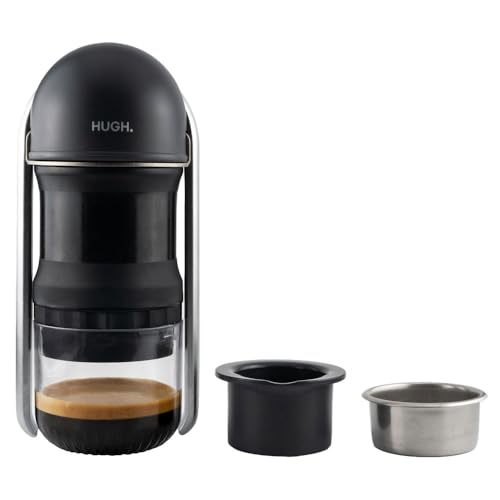There’s no better way to start your day than with a good shot of espresso. Manual lever espresso machines have a charming old-school touch but aren’t always as simple as they sound. These gadgets require the user to pull a lever to force hot water through coffee beans, allowing for greater control over the brewing process and the ability to customize the espresso to their liking.
Here, you will find the best lever espresso machines reviewed and compared so you can choose the one that best suits your needs.
Best lever espresso machines in 2024
Lever espresso machines combine craftsmanship and control in home brewing. It’s more than just pressing a button. These machines allow you to adjust pressure and timing to get the perfect shot of espresso. Whether you’re a seasoned barista or just exploring the options to make espresso at home, the right lever espresso machine can turn coffee-making into an art.
This guide reviews and compares the top lever espresso machines out there, from budget-friendly compacts to premium machines for enthusiasts. There’s something for every coffee lover. The table below shows the main differences to help you choose the right one.
| Image | Product | Features | Price |
|---|---|---|---|
Best Overall  | La Pavoni PC-16 Professional Espresso Machine |
| Check Price |
Personal Favorite  | Cafelat Robot Barista |
| Check Price |
Value For Money  | Flair Classic Espresso Maker |
| Check Price |
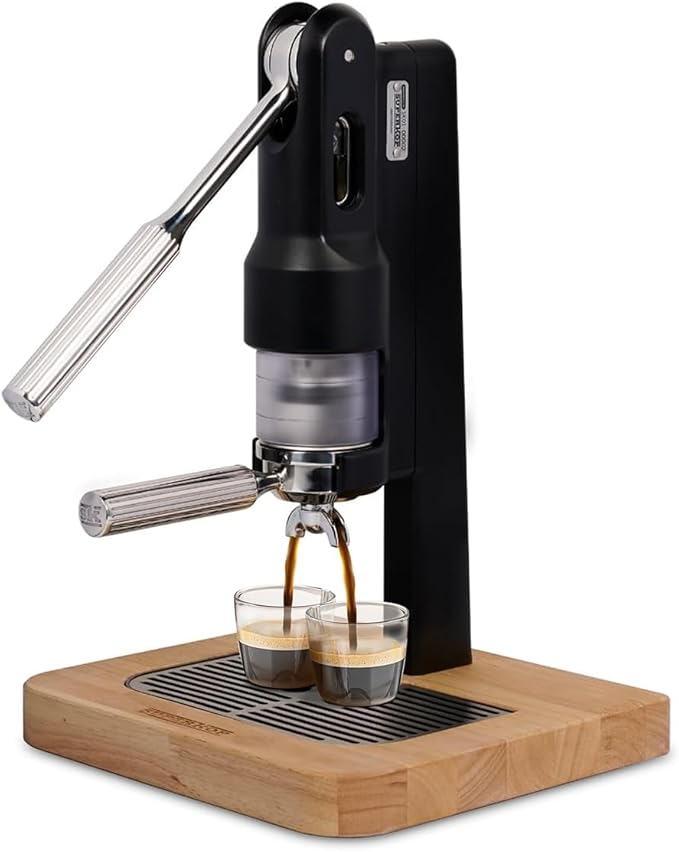 | Superkop Espresso Machine |
| Check Price |
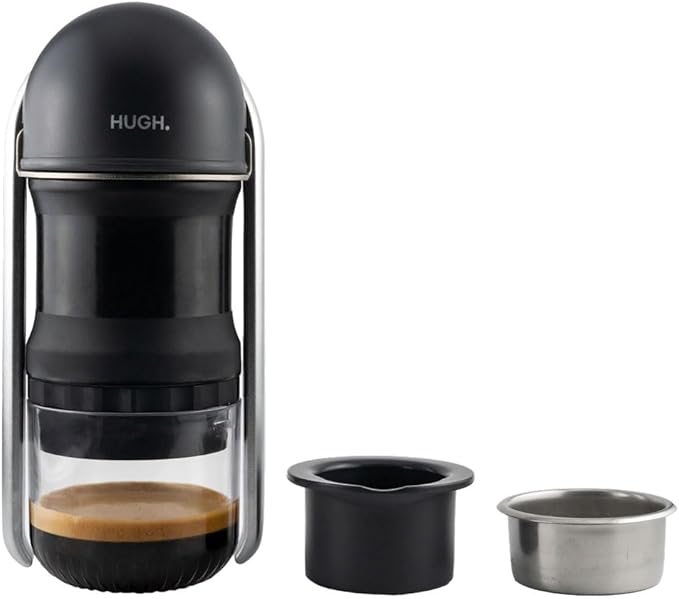 | Leverpresso Hugh V4 |
| Check Price |
 | La Pavoni Esperto Edotto |
| Check Price |
La Pavoni PC-16 Professional Espresso Machine
Espresso aficionados around the world may be familiar with the Pavoni name. In 1905, an Italian man, Desiderio Pavoni, was the first to produce commercial espresso machines.
Although the coffee world has changed due to the development of technology, La Pavoni continues to manufacture high-quality espresso makers in Italy for those who want a taste of the old world. The entire line of La Pavoni machines has a classic design, including the La Pavoni PC-16 Professional.
The La Pavoni Professional features a streamlined design with a chrome finish and black accents. A coat of jewelry varnish maintains the shiny look of the metal.
Beyond the elegant appearance, this machine also has advanced technology. Its generous electric boiler holds enough water to brew 16 espresso shots, and the sight glass on the boiler shows you how much is left. In addition, a pressure gauge is visible at the top of the boiler.
You can extract one or two shots of espresso at a time. If you want an espresso-based coffee drink with milk, you’ll also have to decide whether you’d like to use the machine’s steam wand as is or add the auto-frothing attachment. However, while this high-end manual espresso machine does a lot for you, you’ll still have to learn a few essential skills.
You’ll need to master the craft of the pre-infusion, which is similar to letting the grounds bloom when you do a pour-over. You’ll also have to tamp the coffee grinds evenly to deliver consistent espresso shots.
Maintaining slow and consistent pressure for 25 to 30 seconds will yield a great espresso shot. You can quickly tell from the gauge how well you are doing. Once you perfect the extraction, you will pull full-bodied espressos with plenty of golden crema.
Choosing this time-tested brand means investing in high quality. If you have a large family or want a professional espresso maker in your office, this is the perfect espresso machine for you.
- Large boiler capacity
- Heats up quickly
- Makes one or two espresso cups at a time
- Built-in pressure gauge
- Dual frothing
- Needs to cool down before refilling the water
- It may overheat when used continuously
Cafelat Robot Barista Manual Lever Espresso Maker
Cafelat based its Robot espresso maker design on the old Italian model Faema Baby. The Robot adds a cute and quirky personality to the mid-century modern aesthetic.
The Robot is a unique lever espresso machine that takes the best parts of the vintage design and adds some improvements. Like the Faema Baby, the Robot has two levers instead of one, making it easier to press down when brewing your coffee. Just add hot water (which you will need to heat separately), ground coffee beans, and press.
Other benefits of the Cafelat Robot include its oversized basket rather than a big brew chamber. It is a great solution, as you don’t need to preheat the machine for brewing. The main components of this espresso maker device are made of aluminum, while the filter baskets are made of stainless steel.
The Cafelat Robot can achieve the 9 bars of pressure required for extracting espresso, and it has a pressure gauge so you can see how close you are to that goal. However, some users find that the Robot makes better quality espresso with shots pulled at around 6 or 7 bars. In addition, this lever machine can produce thick crema if you know what you are doing.
To truly appreciate the Cafelat Robot design, you must see it in real life. This manual espresso maker is relatively small, so it will not take up a lot of space and look like a modern piece of art on any kitchen counter.
The only downside to the Robot is that it doesn’t have the feature of steaming milk. So making a cappuccino or latte at home would require using a separate milk frother.
- No electricity required
- Quirky design
- Extremely sturdy stainless steel
- Good water heat retention
- Easy cleaning
- Silicon gasket can wear out if it stays in the portafilter too long
- Needs preheating when using lighter roast beans
Flair Classic Espresso Maker
The Flair Classic Espresso Maker is a sleek, hand-powered lever espresso machine that does not require electricity. It creates enough brewing pressure to mimic the top-of-the-line appliances and their techniques — at a fraction of the cost! Its lower price point makes good value for money. It is perfect when you prefer to start small if pulling espresso is a brand-new skill.
Since it’s human-powered and relatively light (5lbs or 2.27kg), you can take the Flair espresso maker on the go. It comes with a padded travel case for that. However, you will need a way to heat the water separately.
To make espresso with the Flair machine, you need to insert the coffee into the portafilter. Then, fill the water chamber with boiling water, which sits above the coffee. Finally, pull the lever by forcing the water through the coffee grounds.
This creates enough pressure to extract the coffee and get a great espresso shot. The Flair espresso maker reaches 6 to 9 bars of pressure, which is a bit low, but it should still give you a good layer of crema on top.
The detachable brewing head makes cleaning a snap. Just don’t forget to rinse it with water after each use. If you’re worried about putting it back together afterward, you shouldn’t be, as it’s pretty easy to reassemble.
The updated Flair Classic now comes with a pressure gauge to get immediate visual feedback and a target espresso range while pulling shots. This adds to the control of the brewing process and more consistent extractions.
- No electricity required
- Delivers consistent results
- Suitable for traveling
- Easy cleaning
- Affordable
- Metal parts must be preheated
- Makes a single shot of espresso at a time
- Needs to cool down before brewing another shot
Superkop Espresso Machine
The Superkop Espresso Machine is a Dutch-designed manual espresso maker that’s durable and easy to use. The powder-coated aluminum body and steel internal parts will last for ages; the polished stainless steel lever and 58mm portafilter add a touch of class.
Unlike other manual espresso machines that require a lot of force to get the right pressure, the Superkop has a 1:40 displacement mechanism. This means you can get 9 bars of pressure with 5-6 smooth strokes, which suits people of all strength levels.
Superkop espresso maker is easy to use: grind your coffee, fill and tamp the portafilter, place the special water cup filled with boiling water on top of the portafilter, and slide it into the machine. Pull the lever multiple times, and you’ll get a rich and flavorful espresso shot.
Maintenance is minimal, the Superkop is almost maintenance free. After use, remove the used coffee puck, rinse the portafilter and water cup, and it’s ready for the next use. There is no need to backflush or descale like other espresso machines.
The machine’s design allows it to be placed on a countertop or mounted on the wall to suit any kitchen space. Its compact footprint makes it an attractive option for those with limited counter space.
The Superkop Espresso Machine is beautiful, easy to use, and durable. It’s an excellent choice for coffee enthusiasts seeking a manual espresso experience without the complexities and maintenance hassle of traditional machines.
- No electricity required
- Durable aluminum and steel build
- Compact design suitable for small spaces
- Can be placed on a countertop or mounted on the wall
- Virtually maintenance-free
- Requires separate water heating
- Not ideal for making multiple espresso shots quickly
- Manual operation has a learning curve
Leverpresso Hugh V4
The Leverpresso Hugh V4 is a compact and portable manual espresso maker for coffee lovers who want espresso on the go. The two-lever system produces up to 9 bars of pressure for rich crema and full-bodied flavor. Perfect for a double shot of espresso, this machine is great for anyone who likes to experiment with coffee making.
The Hugh V4 allows for smooth and consistent extraction with the ridgeless portafilter basket. The lightweight and durable construction further enhances portability, so this nifty gadget is perfect for travel, camping, or the office.
The manual operation takes some practice to get the pressure and grind right, but the results are worth it. The simple design and compact size makes it perfect for beginners and seasoned coffee enthusiasts.
Although the durable materials contribute to its lightweight, some may feel the plastic body lacks the premium feel of metal. However, the Hugh V4 is an affordable and efficient solution for those who want a high-quality espresso experience without electricity or big machinery.
While the Rok espresso maker does not have a steam wand, it can help you make a barista-grade Americano, cappuccino, flat white, or latte at home. You’ll have to get a handheld milk frother to froth the milk.
- Compact and lightweight design for portability
- Durable construction with BPA-free materials
- Standard 51mm filter basket
- Suitable for traveling
- Affordable
- Requires practice to achieve consistent pressure
- No built-in pressure gauge
- Labor-intensive manual operation
La Pavoni Esperto Edotto
La Pavoni Esperto Edotto is an elegant and unique high-end manual espresso maker. The state-of-art design features hand-crafted wooden handles and knobs, a chrome base, and a stainless steel finish.
Its electric boiler holds enough water to make up to 16 cups of espresso. The mounted gauge helps monitor and control the pressure during an extraction process. Of course, with a machine at this level, you don’t have to worry that you won’t get the 9 bars necessary for making espresso — but it’s nice to see what you are doing!
The Esperto Edotto machine allows the home barista to prepare the espresso you’d get in a specialty coffee shop. The machine’s settings allow you to decide whether you want to produce one or two espresso shots at a time. Either way, you will get thick espresso with plenty of crema. The unit also has a cappuccino attachment if you fancy a frothy cappuccino at home.
A unique attribute of the Esperto Edotto is the ability to use a bottomless portafilter, which allows you to look closely at the brewing process to diagnose the issues. This feature could be great for experienced users, but it is probably not the best manual espresso maker for a beginner.
While it is an investment, La Pavoni Esperto Edotto is worth the price if you want to enjoy cafe-style espresso every morning without leaving your house. Your first few shots might be challenging as you discover how much pressure gets you the desired result. There is a steep learning curve, but if you’ve made it this far, you probably want more than just a basic cup of joe.
- State-of-art design
- Sturdy construction
- Mounted pressure gauge
- Group temperature indicator
- Bottomless portafilter
- 2 frothing systems
- Requires electricity
- Steep learning curve
- Higher priced than other lever machines
Things to consider when choosing a lever espresso machine
Lever espresso makers offer a tactile and artisanal experience. They allow you to appreciate the skill of making the best shot of good coffee. It’s easy to be seduced by a beautifully designed manual espresso maker that offers high-tech features. Still, you need to ask yourself whether the appliance fits your needs. Manufacturing mistakes can lead to refurbished products being sold at a discount. Before choosing the best lever espresso machine for home use, here are the things you should consider.
Type of lever
Two main types of lever espresso makers are spring piston and direct lever. Spring piston machines have the lever upright when resting, and direct lever machines have the lever in a lower position.
A spring piston machine sometimes called a spring lever espresso machine, does some of the work for you. Meanwhile, direct lever machines give you more control over the outcome.
You may find a steeper learning curve for mastering the technique of a direct lever machine. However, all manual devices require practice, especially if you’re used to semi-automatic espresso machines or fully automated coffee machines.
No matter what kind of manual espresso machine you choose, the full control you get from pulling shots by hand is a tradeoff against the convenience of an easy cup of coffee.

Brewing pressure
Espresso coffee machines can generate different pressure, depending on their design. For example, if a device has a pressure below 9 bars, it won’t be enough to extract real espresso.
While 9 bars is the minimum pressure necessary to qualify as espresso, some manual lever espresso machines are advertised as having higher pressure, such as 15 bars or 20 bars. That said, pressure can dissipate while operating the appliance, especially on a lower-end lever espresso machine that claims to have 15 or more bars. As a result, you might end up with about 9 bars by the time you pull shots.
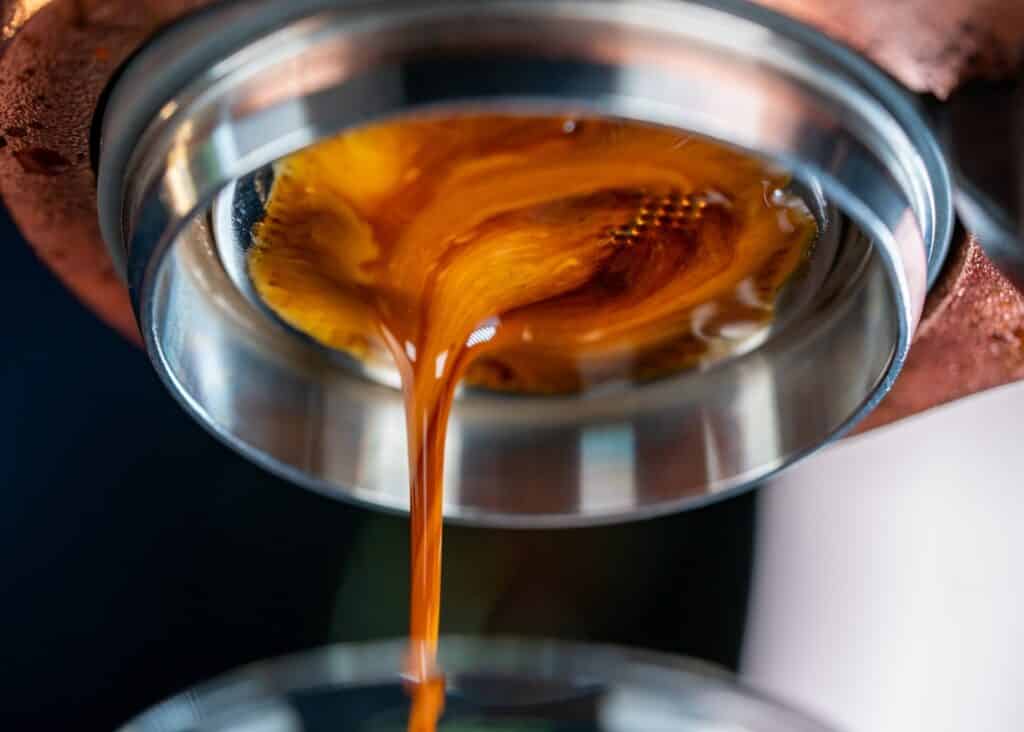
Espresso quality
Espresso shot quality may vary from cup to cup in lower-end manual machines. It is due to instability in maintaining temperature in the machine and lack of complete control.
Are you planning on using your espresso machine to make mostly milky coffees such as lattes and cappuccinos? Then, the espresso quality may be less of a concern for you, as milk will dilute and mask the coffee flavor. Make sure you have a way to steam and froth milk, as lower-end fully manual lever espresso makers don’t have a steam wand.
As with any other coffee machine, you can improve the chances of getting a delicious cup by using freshly ground beans. For an espresso, that will typically be a fine grind. You’ll also need to tamp the grounds with a tamper or spoon.
Factors that affect the quality and taste include the number of boilers present. A dual-boiler espresso machine has one boiler for steam and another for brewing, so it can help if you consecutively pull one shot after another. Other models with just one boiler may need more time between shots.
You’ll also want to consider the highest temperature the lever machine can reach and whether it can maintain it. Note that fully manual lever machines don’t heat water, so you’ll have to add boiling water from an external source.
The coarseness of your grind, under and over-extraction, and consistent steam pressure can all affect crema when pulling espresso. For example, if your crema dissipates after less than a minute, your coffee roast was too light, or the extraction was too fast.
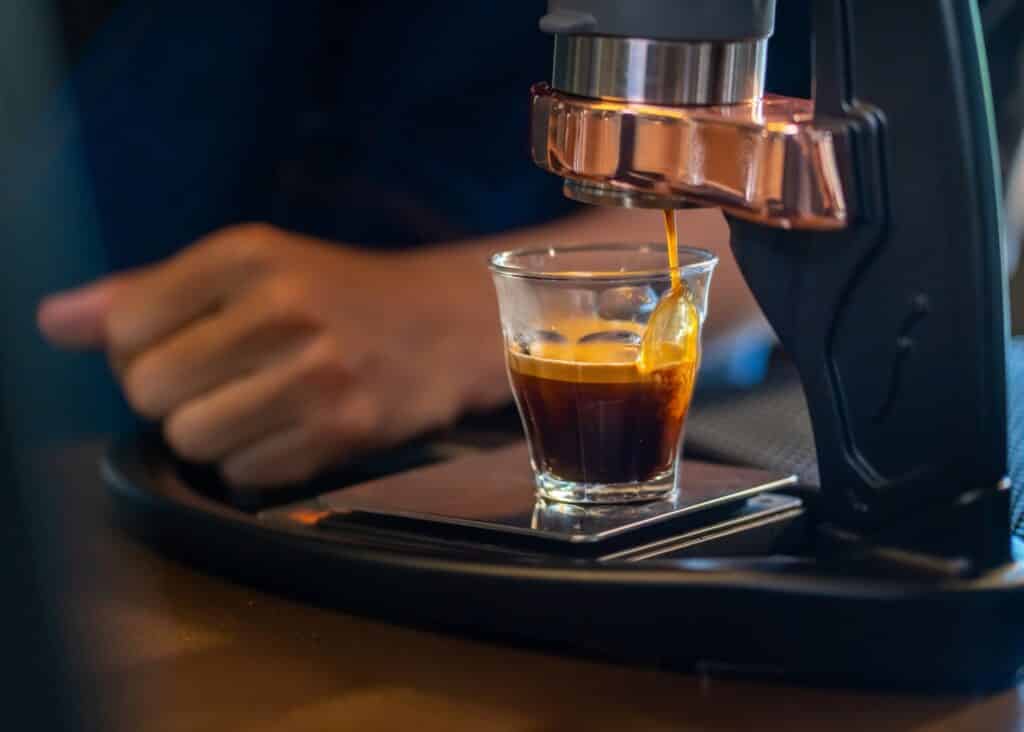
Quantity of shots
Even the best manual espresso machines are limited in functionality regarding the number of consecutive shots they can make, which can be challenging. Eventually, their boilers need to be refilled, and their pressure needs to rebuild between beverages.
Depending on the model, a home espresso machine typically holds between 16 to 50 ounces (0.5 to 1.5 liters) of water. For example, a tank with a capacity of 38 ounces (1.1 liters) can produce 16 two-ounce shots.
High-end lever machines connect to a water supply, so quantity is not an issue. However, these devices are priced much higher and have a steep learning curve.
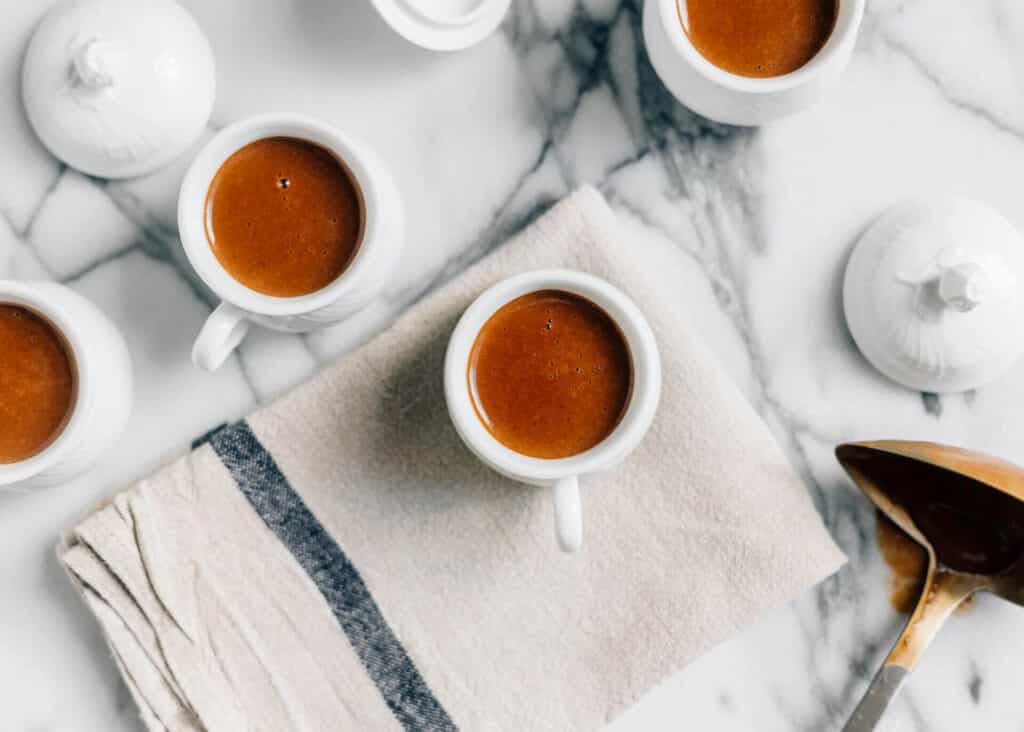
Ease of use
One of the biggest differences between manual espresso makers is the ease of use. It will become clearer as you read through the descriptions and reviews of the different brands and models. Some models, like the Flair 58+, have features such as an articulating shot mirror that attaches to the post magnetically.
Some manual espresso makers are relatively portable and even suitable for camping trips. These are generally the easiest to use for beginners. The ones that can go on the road are usually durable, too.
You might want to take note of the cleaning requirements of different machine models, as it is an often overlooked aspect.
Semi-automatic or automatic machines can operate with less effort than manual ones. The semi-automatic kind allows you to customize your shots, just not as much as you could with a manual machine.
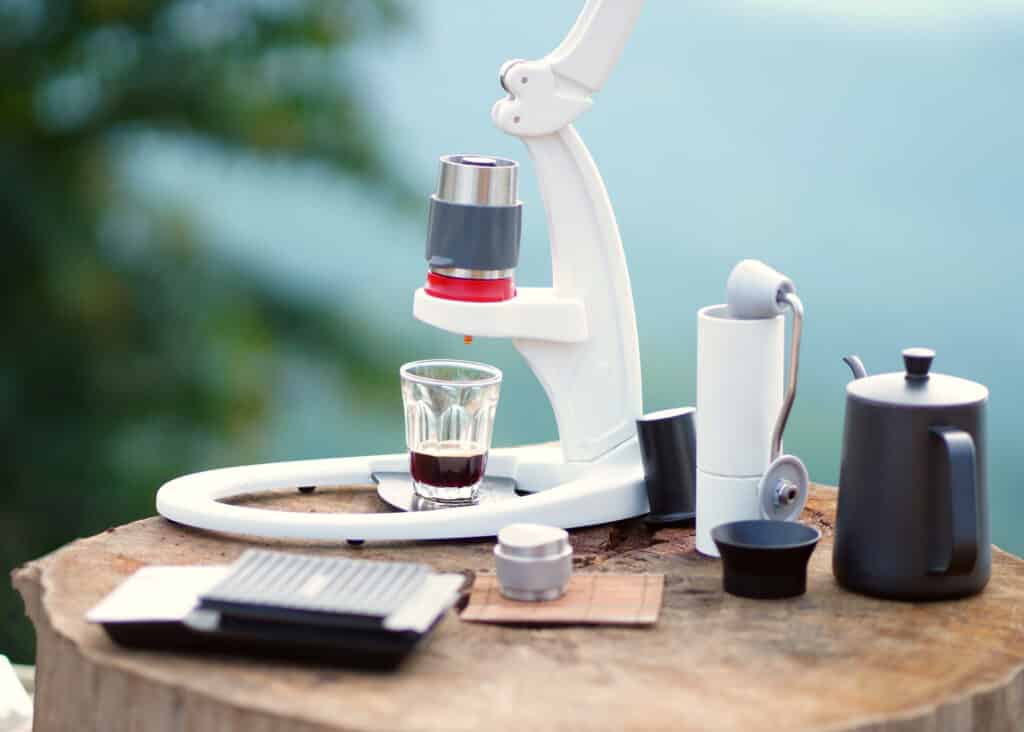
Durability
Before purchasing a manual espresso maker, it is important to know how much espresso the device can handle. Lever espresso machines that are budget-friendly and smaller can overheat or break if used all day — not fun!
Professional-grade and high-end espresso machines should be able to work all day without any malfunctions. It is paramount for manual espresso makers to handle lots of steam pressure.

Price
Lever espresso makers range in price from $100 to over $1,000. Finding a proper espresso machine that costs less than $100 is hard.
If a machine is cheaper than $100, it most likely brews what can be described as an espresso-like beverage. These might be something like Moka Pot or AeroPress coffee — and those affordable brew methods may be a better fit if you don’t want to spend a lot of money.
In the long run, a manual espresso machine might not be much cheaper than automatic and semi-automatic machines. Therefore, when you are ready to invest in a manual espresso machine, it’s best to focus on other factors besides price to get the best value.

With practice, you’ll learn what to adjust to get more crema and less bitterness — or vice versa, depending on your tastes. Of all the ways to brew espresso, a lever machine would give you the most control over your shot.
Do you look at the descriptions of the best lever espresso machines and feel like they require too much work or sound too complicated? There’s no shame in admitting that something like a Keurig or Nespresso might be a better fit for you. Also, you may want to consider an AeroPress or a handheld portable espresso maker, even if you don’t plan to take it outside your home. After all, the best gadget for you is the one you’ll actually use!




